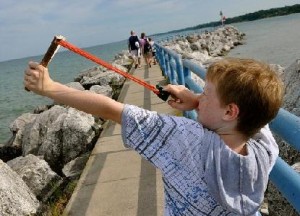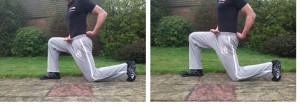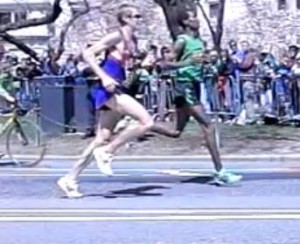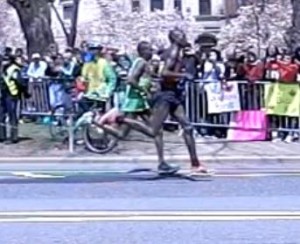In last week’s article “How Does Cadence Affect Injury and Performance,” we saw how making a small change to one’s running mechanics can have a significant knock on effect elsewhere in the body.
It is important that we remind ourselves that this change can be for better or for worse, so when modifying our running form it is vital that changes are made gradually (5-10% increments in the case of cadence) and that we listen to the body throughout the process.
Likewise, as we have discussed before, “correct” running form is very much individualized; what works for one will not necessarily work for all.
With that said, there are some “big picture” topics or ideas that generally apply across the board. And one of these is the idea of “gravity”. And that’s what we’re going to discuss today.
Leaning forward: does gravity help?
One idea that has gained popularity through the emergence of structured running styles is that by leaning forwards when we run we encourage “gravity to help propulsion.”
Although I am of agreement that a slight forward lean can indeed help increase running efficiency, I sometimes feel that attributing it to “getting help from gravity” can mask what I regard as a more beneficial explanation of the purpose of a forward lean, and help runners avoid the common error of leaning forwards from the waist as opposed to leaning the whole body slightly forwards in a straight line, from ankle to shoulder.
When Amby Burfoot, Editor-at-Large for Runner’s World, asked running expert panelists Michael Tammaro, Ph.D. (Physicist), Steve Magness, and biomechanist Irene Davis, Ph.D. (director of the new National Running Center at the Spaulding Rehabiltation Hospital in Boston) if leaning forwards helps you run more efficiently by letting gravity do some of the work, the consensus was:
“Gravity can do nothing to improve your running efficiency on a flat surface. That’s because gravity provides no horizontal force; it simply pulls you back down to the earth.”
All three of the panel did however favor a slight forward lean while running.
So what’s it all about?
The importance of hip extension
Last week we saw that during swing phase (when the foot is in the air, from toe-off to foot strike), propulsion of the leg forwards is a passive movement (i.e. with no conscious effort) using a stretch-reflex similar to a sling-shot.

The drawing back of the slingshot is equivalent to the hip flexors (at the front of the hip) lengthening under tension.
As the body moves over the weight-bearing foot, the hip flexors store elastic energy that will later be used for propulsion.
In other words, the more we manage to lengthen the hip flexors under tension, the stronger the forward propulsion (firing) of the leg will be.
So, let’s imagine what happens if you bend forwards at the waist whilst running. You are in effect reducing the range of movement available in the hip flexors, reducing the amount of tension you can achieve, and thus reducing the level of propulsion.
In other words, you are reducing the power of the sling-shot.
This is why having restricted range of movement in the hip flexors can limit running efficiency. The level of propulsion is limited by the amount of elastic energy you are able to store in the hip flexors during hip extension (and likewise during knee and ankle extension where the stretch reflex is also used).
Use it or lose it
Unfortunately, making a living for most of us involves holding the pelvis in a relatively fixed position throughout the day, be it sitting in front of a computer, at the wheel of a car or standing in front of a whiteboard.
The static nature of our daily life is one reason why the hip flexors (at the front of the hip) lose the dynamic mobility required for optimum running efficiency. As a result, runners with restricted hip flexors typically tend to achieve hip extension (get the supporting leg behind them) by dropping the pelvis forward and arching the lower back. This allows the body to pass over the weight bearing foot without the hip flexor needing to lengthen so much.
However, as we have seen, less lengthening of the hip flexors under tension means less storing of elastic energy, meaning less propulsion. By reducing the efficiency of the running action, the lack of pelvic stability can create extra loads on the leg muscles and/or increase stress through the lumbar spine and pelvis. Either of these may increase the chances of injury.
Lean from the ankles, not the waist
Promoting efficient hip extension is one of the main rationales behind adopting a slight forward lean when running. The lean itself needs to start at the ankles and promote alignment of the whole body in a straight line, all the way up to the shoulders.
Maintaining this alignment over long distances however does require a certain level of conditioning, which is why strength and mobility exercises play such an important role in improving running performance.
Weak hamstrings, glutes and lower back can lead to too much of a forward lean, whilst tight quadriceps and hip flexors can encourage leaning forwards from the waist.
Typical cues include “lead with the hips”, “keep your hips pressed forward” and “tuck your backside under your hips” but unless you have sufficient strength and dynamic mobility to maintain such alignment, the coach can keep shouting as much as they want.
Running Biomechanics researcher Jay Dicharry describes how restricted hip extension can also cause runners to run in the “back seat” with their weight over the heel. According to Jay’s studies, this can promote overstriding and the associated problems that we considered in last week’s article.
Testing your hip flexor mobility
A good way to test your range of movement in the hip flexors (all be it in a static environment) is the kneeling tilt. Normally, this is how it goes:
- When you first get into the kneeling position (see photo below), note how much tension you feel up the back leg, from the knee to up the thigh and across the hip. The chances are you will not feel too much (as your body will tend to hold your pelvis in a position that avoids tension).
- Try and tilt the pelvis upwards, such that the waistline at the front of your trousers moves to level or a little higher than the line at the back (as in the right photo below).
- In other words, tuck your backside under your hips. For many, this movement will not come easily as it requires a coordination of muscle recruitment that your body is probably not familiar with. You may need to practice the movement lying down (tilting your pelvis so your lower back touches the floor) in order to engage the necessary muscles, and then try it again in a kneeling position.
- Those of you of who can tilt the pelvis upwards (without moving the rest of the body) should now get an indication of any restrictions you may have in hip flexion.
As is often the case, the test becomes the exercise to reduce restrictions. Don’t forget to test and compare both sides!

No one running style reigns supreme
Having given so much weight to the benefits of a slight forward lean from the ankles, it is once again important for us to remember that no one running style suits everybody or indeed wins all races, even at elite level.
The screenshot below taken from the Boston 2011 Marathon shows Gebre Gebremariam (in the green singlet) who finished third with a personal best of 2:04:53 (third also in 2013 with a time of 2:10:38), and Ryan Hall (blue/red singlet) who finished 4th with an American record time of 2:04:58 (but sadly had to pull from Boston 2013).
Just 5 seconds between them, and yet the differences in style are obvious: Hall showing a slight forward lean whilst Gebremariam exhibits a very upright torso.

“What about the 2011 winner and runner up?” I hear you say. Well, in the photo below, you can see Geoffrey Mutai (in the green singlet) who won with a time of 2:03:02, and Moses Mosop (black/red singlet) who came second in 2:03:06. Maybe a slight forward lean is the way to go for the majority of us!

As always, feel free to use the comment box below for debate as the world of running performance is rarely black & white! We welcome your personal experiences, questions and suggestions for future articles.
Happy running!





14 Responses
Hi Matt,
Nice article. Allow me to nitpick :). I have few comments/questions about the importance of hip extension and how hip flexor power is generated.
I absolutely agree that creating hip flexion power at the end of the stance phase is important. Not only does this torque create hip flexion it also creates knee flexion. But we differ a bit in the following areas:
1. You suggest that Hip flexion is a “passive” activity: while there is certainly a passive component to the stretch shortening cycle there is still an active component in the hip flexors during running. We know from the research of Ralph Mann and Andersson (http://www.ncbi.nlm.nih.gov/pubmed/?term=psoas+EMG+running) that the hip flexors are not myoelectrically silent at the end of the swing and that they are actively contracting to drive the hip forward.
2. The idea that the monosynaptic stretch reflex is a big driver of hip flexion should also be questioned. The amount of force produced from a stretch reflex (think about the patella reflex) is quite minimal. This has been modelled in spine stability studies showing that while reflexively stability is important it contributes very little to force production.
3. I question the idea of tight hip flexors being a deterrent for those hip flexors to store and release passive elastic energy. Runner’s have tight calves in general and we are fine with that as we call them tight springs. They probably have a better ability to store and release energy. If the hip flexors are tight they will still undergo some tension and will store and release energy. Being looser would not make those hip flexors any less able to be stretched and release energy. Staying with your slingshot you just have a stiffer elastic. It can be just as powerful if not more so.
4. Why is greater stretch better? When you do a standing vertical jump it is not the athlete who drops into a deeper squat that gets more explosive. The same can hold true of “tight” hip flexors.
I think “tight” hip flexors influencing running efficiency is an interesting idea but thats all it is now. Just an idea. There isn’t really any strong research showing that runners with tight hip flexors are less efficient and that stretching those hip flexors will improve running.
Jay’s running in the back seat is still just a theory. I wrote about it here (http://www.thebodymechanic.ca/2012/09/08/running-in-the-backseat-a-rationale-for-improving-hip-extension-in-runners/). He has not published any studies on it.
Last, we even have some work (Schache 2009) showing that our tests for tight hip flexors (the thomas test, not Jay’s test) does not correlate with hip extension range during running.
All the best,
Greg
Hi Greg. Honoured to have a response from you! Nitpick as much as you wish!
As I see it (and I dare say this is an over-simplification), optimum propulsion in running is a product of possessing a large enough range of motion in the hips and ankles to achieve maximum extension of the leg before the foot leaves the ground. It is stride length combined with stride frequency that determines the degree of force produced from the stretch reflex, which in turn produces a powerful yet passive knee drive forwards. Restricted mobility in the hip flexors would limit the stride length and as a result limit propulsion.
In one’s quest to improve running performance, I would suggest any attempt to actively raise the knee is a case of trying to treat the symptom rather than the cause. The same applies to heel pick up. This can be the danger of splitting the gait cycle up into individual components – useful to help understand the overall biomechanics of gait but a distracting temptation to try and develop one moment of the cycle in isolation, instead of the whole body approach that I feel is vital.
I lean towards the theory (which after all is all this is) that the active part of the propulsion phase need only start when the knee has reached its highest point on the forward swing phase. It is here that the runner actively begins to extend the leg and knee by pushing the foot downwards under the body using the glute & quads. As soon as the foot makes contact, it’s all about elastic loading and unloading powering the body forwards. In other words, the degree of knee lift should not be a product of active hip flexion but a result of the powerful down push that preceded it.
As far as evidence goes, apart from looking at the stride length achieved by elite runners, I must admit I am struggling to find papers that have researched it degree of hip extension and running performance. I would persevere more but my wife is currently giving me evils so I really must wrap things up for now! I totally agree the Thomas Test has its limitations when it comes to addressing dynamic hip extension, and for this very reason I rely on video gait analysis to get a true image of what is happening.
Thanks for taking time to leave a comment Greg. I look forward to your response!
Hey Matt,
I still advocate that athletes work on hip extension and because I advocate it I question it because we don’t have a lot of research on it.
There is one paper that looked at elite middle distance runners and hip kinematics during a race (thus not in a lab). If memory serves me they found less hip extension in the elites: http://www.ncbi.nlm.nih.gov/pubmed/19391490 I can email this paper if you don’t have it. Other than this one there is not much out there. It is worth noting that sprinters don’t have greater hip extension than runners.
As speed increases our contact time decreases so there is not as much time to produce force.
I still don’t think its the stretch REFLEX that produces the force. Especially if you mean the monosynpatic stretch reflex. This reflex is pretty weak. Yes, the muscle does stretch but we can’t attribute the force generation from this stretch as being mostly reflexive.
I’d love to see the research study investigating whether training to increase hip extension (both with stretching and then via gait retraining) leads to a decrease in overstriding and rate of impact loading.
All the best,
Greg
Gravity can indeed move a runner horizontally when acting of over a lever, such as the body when held rigid. If gravity could not move objects forward, then nothing would ever fall over, monkeys would be unable to swing through trees, and the Leaning Tower of Pisa would be completely safe. The key is that gravity must be acting over a lever, and levers, as we should all know from basic physics, change the direction of a force.
Hi Ken. Thanks for the comment. Great to have a running coach of your experience in here!
Sorry but I just can’t seem to get my head around how gravity can “move a runner horizontally”. It can definitely cause a runner to fall over (I think we’ve all been there!) because by definition gravity is constantly pulling objects towards the centre of the earth, but I fail to see how anything pulling us downwards can help us move forwards (unless of course we are running downhill). Basic physics would have me believe that gravity limits forward movement, not facilitates it. If running is the art of overcoming resistance, that for me would include overcoming gravity. In a nutshell, I can see how gravity can cause a monkey to fall out of a tree, but not help propel it through them. That said, it’s a fascinating area of running and in the interest of moving forwards (excuse the pun), I am always keen to learn more about the different theories.
Matt,
It seems everyone attended physics class for the lecture on the force gravity acting on unsupported objects, but then completely missed the lecture on levers. Levers do change the direction of a force period, and that includes the force of gravity.
Gravity can both limit an facilitate forward movement depending on many factors, but once you pass over your center of gravity, you are off balance and falling both horizontally and vertically through an arc while your supporting leg is on on the ground. For the first 21.5 degrees of that arc, the horizontal component is dominate.
Stand a broom on it’s end and let it fall. It will fall through an arc to the floor, it does not drive straight in the ground, and I’m pretty sure that the broom is not pushing itself forward. There you go, strong evidence that gravity can move an object forward when acting over a lever.
Ken, did the bottom part of the broom move forward? The broom, (your lever) is simply rotating about the end in contact with the ground, but the end DOES NOT MOVE forward because there is no horizontal component of gravity. The earth’s gravity acts in a normal direction to the earth’s surface. Chi and Pose both persist in passing on information that defies the laws of physics, (at least the laws of the planet I live on, perhaps Danny Drier and Pose both come from a different planet)
Alright so people are actually brooms (leavers) that are top heavy and have 2 variable points of contact with the ground that can provide both vertical and horizontal force. A falling broom (person) could put one of those points in front of the other (a step) propping it back up to nearly vertical be for gravity makes it fall again.
Top heavy leavers with two load bearing pivots able to apply force in 3 directions are pretty complicated however.
So let’s assume this broom has a wheel for a base and that it’s weight is evenly distributed.
Gravity acts downward at 10m/s/s if the broom is vertical it will stay still. If the broom is at an angle of 45 degrees (1:1), the wheels which can only act horizontally must move at 10m/s/s in order to keep the broom at 45 degrees.
However, if the broom is vertical and the wheels move horizontally, gravity will make it fall over in the opposite direction.
Can gravity transfer into horizontal force? The answer is no. With an angled falling broom and a perfect wheel (no friction) the center of the broom will move directly down and the leaver will rotate until flat with both ends transversing in equally opposite horizontal distances.
But … due to gravity an angle is a must when accelerating in order to prevent the leaver from falling over backwards (sprinters starting off crouched).
This is the limit of our wheeled broom analysis as the physics behind the constant speed of a runner is governed by constant decelerations (wind resistance & gravity) and multiple relatively instant accelerations (steps) in both the horizontal and vertical directions.
So in summary does gravity influence horizontal speed? No, but it definitely influences what angle your body needs to be at! Along with a whole range of other factors that influence the runners style (head wind being the most obvious).
Thanks for sharing Michael. A very in depth, but clear explanation for those readers who truly want to understand why this is the way it is. Great analogy, and makes it easier to understand from a visual perspective. Thank you for your response!
Matt, Here is more complete explanation.
http://www.posecoachblog.com/2012/09/pose-theory-three-primary-points-of.html
G’day Matt, thanks for the great article. Couple of observations/theories. Generally middle distance runners exhibit less forward lean and sometimes sit a little deeper – more power down and glute oriented than the marathon crowd who generally run with hips a bit higher and more forward with a more rolling gait. Although notable exception the late Sammy Wanjiru seemed to sit very deep and there are others.
I find leaning forward from the ankles a problematic coaching cue. I know what people mean, but most runners don’t have the foot or total body strength to mimic elite postures. Can lead to floppy feet, calf issues and less glute activation. The Ryan Hall pic near toe off is a good example his foot is held pretty strong, his knee is still flexed and his thigh is only just about to go into extension. It’s a very strong posture that loads the calf and foot well. Nothing passive about it to which leaning forward from the ankles as a cue seems to imply.
Hi,
Regarding the lean, it is important regardless of what you think of the role of gravity in running. Try to push against the ground without having placed your body at a forward angle. Where do you go? Nowhere but up. To make the push carry you forward, if you believe that is what it does, you have to be at a forward angle to achieve the forward movement. Anyway, the runner’s center of gravity is only directly above it’s base of support for a very brief moment. The rest of the time, while the foot is on the ground, it is either at a slight backwards angle, or forward angle, relative to the base of support. There is no way to run without letting that happen.
Comment on two points: gravity and leaning. Coming form an engineer, gravity does not propel is correct. It aids propulsion. When you stand perfectly erect you have two forces on your body, the action which is gravity acting on your body. This can be represented with one downward force acting on the center of gravity (COG) which is in the pelvis when standing up. The second force is a reaction force of the ground on your feet. When standing straight up the two forces point directly through each other so you are equilibrium. When you lean forward, your center of gravity (COG) is now in front of your support. Now the forces are not aligned which creates a torque (or force couple) on you body. This is why your body rotates (you fall down.) If you don’t want to hit the ground you need to change the direction of the force at your foot. So you thrust backward. You are still also pushing up at the same time against gravity, but now the resulting backward thrust points the resultant force back toward the body’s COG so there is no longer a torque on the COG. That’s how a sprinter can be leaning way forward out of the blocks and not fall on their face! So thrusting backwards creates a forward force on the shoe (equal action/reaction of shoe and ground – also why spikes help.) So gravity facilitates by creating a torque on the body when we lean forward so we can react against it. If we thrust the foot back without leaning forward, we’ll fall on our butt. Think about this: Once you have accelerated to cruising speed, if the breeze were moving your speed and your direction and there were no hill you need zero horizontal force and therefore no lean to keep moving. So any forward lean at that point requires some degree of breaking force in your stride to keep from accelerating further. The only time you need to lean “from the ankle” is with wind resistance or with a hill. Sorry if it’s too nerdy but I hope it can clarify some points on the physics and some of the practical implications.
Forgot the comment on leaning. The physics shows why little to no leaning (very little to overcome a little breeze or a lot on a steep hill) is needed to cruse. Big problem is when it translates to leaning at the waist. If the more you bend at the waist the harder it is to activate the glutes in the stride. Your glutes are the primary hip extensor. If you don’t use your glutes to run you will be using secondary muscles and stabilizers and you will be hurtin’ bad (knees, IT band, calves, hamstrings, etc.)